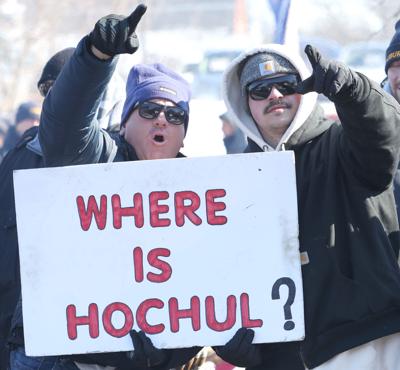On the 11th day of the New York correction officer strike, the state Department of Corrections and Community Supervision revealed how many employees are participating in the walkout.Â
About 90% of the state's 13,500 correction officers and sergeants are considered absent without leave, according to DOCCS. They represent a vast majority of the state correction officers, which include nearly 400 lieutenants who are still on the job.Â
After the strike began, Gov. Kathy Hochul activated and deployed more than 6,500 National Guard members to correctional facilities. State troopers are handling perimeter security at select prisons.Â
People are also reading…
The number of correction officers on strike shows why Hochul views it as an urgent matter. She has repeatedly called on striking officers to end their work stoppage. A judge issued a temporary restraining order requiring the officers to return to work, but they have defied that directive and continued their protest.Â
Last week, DOCCS took actions in an attempt to end the strike. The agency temporarily suspended parts of the Humane Alternatives to Long-Term Solitary Confinement Act, known as HALT, that has been blamed for the spike in prison violence. Daniel Martuscello, the department's commissioner, also rescinded a controversial memo that directed prisons to consider 70% as full staffing levels.Â

Correction officers react during a community drive-by parade supporting their strike at Auburn Correctional Facility to protest unsafe working conditions.
DOCCS offered amnesty for officers to end the strike and return to work. Most officers, though, remain on the picket line.Â
Shortly after the strike began, the officers issued a list of demands. They want HALT repealed, suggested ways for DOCCS to boost recruitment and proposed changes to prison operations, such as how mail and visitor body scans are handled.Â
Another issue not raised in the officers' demands is mandated overtime. During the ongoing staffing shortage, officers have been forced to work longer shifts, sometimes 16 or 24 hours.Â
Hochul, who provided an update on the state's response to the strike Tuesday, acknowledged the difficulties officers face with the overtime requirements.Â
"That is not acceptable to me," she said. "It is not good for them, their families or our state."Â
However, when asked whether the strike is too long, Hochul responded, "Yes."Â
"We offered them amnesty after a day or two," she continued. "They could've gone back. You've made your point, thank you. We hear you. I get it. The hours and shifts are too long. But when they are not represented by a union, and I'm negotiating with a union, I'm asking a union, 'What do they want?'"Â
The officers are represented by the New York State Correctional Officers and Police Benevolent Association. NYSCOPBA did not sanction the strike and urged its members to return to work.
The state is taking action against the striking correction officers. The state police has already served nearly 400 officers with court papers ordering them to return to work. If they don't follow the court orders, they could be arrested.
Those participating in the strike could also face penalties under the state's Taylor Law, which prohibits public employee strikes. They can be docked two days' pay for every day they are on the picket line and risk losing their jobs.Â
DOCCS and NYSCOPBA are participating in mediation sessions that began Monday with the goal of ending the strike. Mediation continued Thursday, with NYSCOPBA expecting an offer from the state. As of 4:30 p.m., both sides were still meeting.
In a statement, DOCCS said "all parties remain committed to finding a path toward a fair and timely resolution to this illegal job action." The agency described the talks as "constructive."Â
Government reporter Robert Harding can be reached at (315) 664-4631 or robert.harding@lee.net. Follow him on X @RobertHarding.














